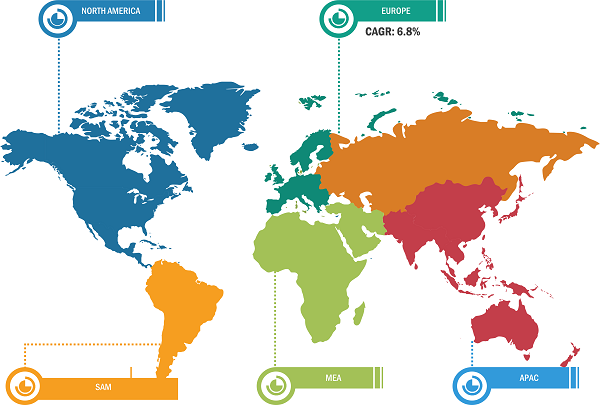Technological Advancements in Flavor Masking Drives Flavor Masking Agents for Food and Beverages Market Growth
According to our latest market study on “Flavor Masking Agents for Food and Beverages Market Forecast to 2030 – COVID-19 Impact and Global Analysis – by Type and Application,” the flavor masking agents for food and beverages market size is projected to grow from US$ 134.32 million in 2022 to US$ 211.98 million by 2030. The market is expected to record a CAGR of 5.9% from 2022 to 2030. The report highlights key factors driving the market and prominent players along with their developments in the market.
Flavor masking agents are used in food products and beverages through various techniques and technologies such as microencapsulation, nanotechnology, polymer coating, organoleptic methods, hot melt extrusion, complexation, and spray drying. Nanotechnology aids in enhancing the solubility and stability of flavors, as well as providing controlled release properties. Thus, manufacturers increasingly use nanotechnology to make flavor masking agents.
Flavor Masking Agents for Food and Beverages Market Breakdown – by Region

Flavor Masking Agents for Food and Beverages Market Size 2030
Download Free SampleFlavor Masking Agents for Food and Beverages Market Size and Forecasts (2020 - 2030), Global and Regional Share, Trends, and Growth Opportunity Analysis Report Coverage: By Type (Sweet, Salt, Fat, Bitter, and Others) and Application (Bakery and Confectionery; Dairy and Frozen Desserts; Beverages; Meat, Poultry, and Seafood; Meat Substitutes; Dairy Alternatives; RTE and RTC Meals; and Others)
Moreover, microencapsulation is a relatively new technology in which the flavor content is encapsulated in a solid matrix. The flavor is released when the substance is heated or exposed to water. Spray drying, coacervation, polymerization, and other techniques are used in microencapsulation. In the microencapsulation process, the oil/water mixture is homogenized in the presence of wall material, followed by controlled spray drying. Wall materials include vegetable gums, starches, dextrin, proteins, cellulose esters, and others. Microencapsulation provides controlled flavor release at the right place and desired time. It protects the active ingredients (flavors) from moisture, acid, heat, oxidation, and ingredient interaction. It also provides the ease of handling ingredients as they are dry and free flowing, reducing overall transportation and handling costs. Microencapsulated flavor masking is highly shelf-stable, making it more desirable than other formats. The technology is not just for flavor and odor masking; it can also improve stability, prevent ingredient interaction, and modify the release of ingredients. Thus, technological advancements in the manufacturing of flavor masking agents bolster the flavor masking agents market growth across the world.
Sensient Technologies Corp, Firmenich International SA, Tate & Lyle Plc, Archer-Daniels-Midland Co, Kerry Group Plc, Carmi Flavor & Fragrance Co Inc, Synergy Flavors Inc, Virginia Dare Extract Co Inc, GEO Specialty Chemicals Inc, and Koninklijke DSM NV are among the major players operating in the global flavor masking agents for food and beverages market. Market players focus on developing high-quality products to fulfill the varied requirements of end users. Moreover, these key players adopt strategic development initiatives to expand their market presence.
Impact of COVID-19 Pandemic on Flavor Masking Agents for Food and Beverages Market
Various industries suffered severe disruptions due to disturbances in supply chains and shutdowns of production plants amid the COVID-19 pandemic. The shuttering of banks, manufacturing plants, and factories in regions such as North America, Asia Pacific, Europe, South America, and the Middle East & Africa disrupted supply chains, manufacturing, delivery schedules, and product sales. Many businesses announced possible delays in product deliveries and slumps in their future sales. Supply chain disruptions, raw material and labor shortages, and operational difficulties created a demand and supply gap that resulted in increased prices of flavor masking agents, hampering the market growth. However, the COVID-19 pandemic altered consumer preferences as health became the top priority. The preference for all-natural, organic, and GMO-free ingredients increased. Thus, the demand for flavor masking agents with above mentioned claims increased among food and beverage manufacturers.
In 2021, various economies resumed their operations as country governments announced relaxations in the previously imposed restrictions, which, in turn, bolstered the flavor masking agents for food and beverages market. Moreover, manufacturers were permitted to operate at full capacities, which helped them overcome the demand and supply gaps. All these factors have been favoring the growth of the flavor masking agents for food and beverages market in the post-pandemic recovery period.
The report includes the segmentation of the flavor masking agents for food and beverages market as follows:
Based on type, the flavor masking agents for food and beverages market is segmented into sweet, salt, fat, bitter, and others. By application, the market is segmented into bakery and confectionery; dairy and frozen desserts; beverages; meat, poultry, and seafood; meat substitutes; dairy alternatives; RTE and RTC meals; and others. By geography, the market is broadly segmented into North America, Europe, Asia Pacific (APAC), the Middle East & Africa (MEA), and South & Central America. The flavor masking agents for food and beverages market in North America is further segmented into the US, Canada, and Mexico. The European market is subsegmented into Germany, France, the UK, Italy, Russia, and the Rest of Europe. The flavor masking agents for food and beverages market in Asia Pacific is further segmented into China, India, Japan, Australia, South Korea, and the Rest of Asia Pacific. The market in the MEA is further segmented into South Africa, Saudi Arabia, the UAE, and the Rest of MEA. The flavor masking agents for food and beverages market in South & Central America is subsegmented into Brazil, Argentina, and the Rest of South & Central America.
Contact Us
Phone: +1-646-491-9876
Email Id: sales@theinsightpartners.com